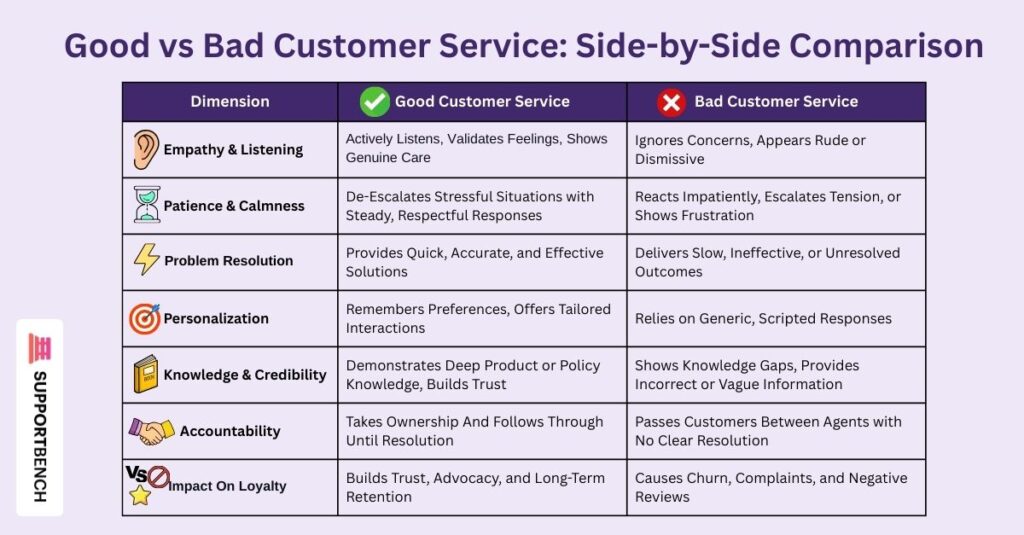Customer service is the backbone of your business success. When executed well, it cultivates trust, loyalty, and positive word-of-mouth, while poor customer service results in churn, negative reviews, and lost revenue.
The difference between good customer service and bad customer service isn’t just about how customers feel in the moment. It’s measurable in key metrics like CSAT, NPS, and CLTV, which reflect the long-term health of your customer relationships.
This guide breaks down what makes service good or bad, with real-world examples that highlight the contrast. You’ll also learn how to track the impact with KPIs and how to strengthen your team through training and tools like CRM platforms.
The goal: turn every interaction into an opportunity for retention and growth.
At a Glance:
Good customer service builds loyalty and repeat business by combining empathy, efficient problem-solving, and personalized support. Bad customer service, on the other hand, drives churn, damages reputation, and limits growth. Training your team and using tools like Supportbench help ensure every customer experience strengthens your brand.
What makes customer service good?

Good customer service is more than solving problems — it’s about creating positive, memorable experiences that strengthen trust and loyalty. Customers come back not just because their issue was fixed, but because they felt respected, valued, and understood.
Here are key characteristics of great service:
Empathy & Active Listening
Good customer service requires empathy to show customers their concerns are heard. Whether it’s addressing an urgent issue or just lending a friendly ear, customers should always feel valued. Bad customer service, on the other hand, often comes across as dismissive or rushed, leading to negative customer service experiences.
Example: Zappos, often cited as one of the world’s leading customer service brands, once sent flowers to a customer recovering from medical treatment — turning a simple transaction into a lasting emotional connection.
Patience & Calmness Under Pressure
Customers may feel stressed, impatient, or upset. A patient response helps de-escalate tension and builds trust.
Example: Amazon’s one-click replacement process for late or damaged deliveries ensures customers feel prioritized, making resolution seamless and stress-free.
Efficient Problem Resolution
Customers expect quick, accurate solutions when problems arise. Resolving issues efficiently reduces frustration, builds confidence, and shows respect for the customer’s time and loyalty to the brand.
Example: Poor customer services can arise when issues are unresolved, leaving the customer frustrated. In contrast, quick resolutions build long-term trust.
Personalized Customer Interactions
Personalization creates stronger connections by making interactions feel meaningful. Remembering preferences and tailoring support shows customers they are valued as individuals, fostering long-term trust and repeat business.
Example: Starbucks’ rewards app remembers customer orders and preferences, offering personalized recommendations and rewards that keep customers engaged.
Deep Knowledge & Credibility
Service reps need strong product or policy knowledge to provide accurate, trustworthy answers. Confidence and expertise build long-term credibility.
Example: A knowledgeable tech support rep quickly resolves an issue, reinforcing trust and credibility with the customer, ensuring they remain loyal to the brand.
When businesses consistently show these qualities, they don’t just resolve issues — they create loyalty, advocacy, and long-term value.
What makes customer service bad?

Understanding what makes bad customer service starts with recognizing common patterns — neglect, poor training, or a lack of accountability. These issues not only frustrate customers but also damage brand image.
Poor Communication
When representatives fail to communicate clearly, customers are left confused and frustrated. Misunderstandings grow, issues remain unresolved, and customers lose confidence in the company’s ability to meet their needs. What’s bad customer service here would be vague or delayed responses that worsen the situation, leading to negative reviews.
Example: Airlines that provide vague updates about delayed flights often create more anger than the delay itself, because passengers feel ignored.
Inadequate Training
Without proper training, employees lack the skills and knowledge to deliver quality service. This results in frequent mistakes, slower problem resolution, and an inconsistent experience for customers.
Example: A fast-food chain that repeatedly gets orders wrong at the drive-thru demonstrates training gaps, damaging customer trust with every mistake.
Lack of Accountability
When no one takes responsibility for addressing customer issues, problems linger. Customers feel ignored, leading to dissatisfaction, damaged trust, and a higher chance of losing their business altogether.
Example: Telecom companies often face criticism when customers are passed between multiple agents without resolution — a clear sign of a lack of ownership.
Good vs Bad Customer Service: Side-by-Side Comparison

Ultimately, what is bad customer service comes down to failing the basics: empathy, accountability, and consistency. Even a single weak link in these areas can turn an average interaction into a churn risk.
These differences don’t just define customer experiences — they directly influence measurable performance outcomes.
Customer Service Metrics: Measuring the Impact
Customer service quality isn’t just about perception; it’s measurable. The following KPIs reveal how good vs bad service impacts business performance:
CSAT (Customer Satisfaction Score)
✔ Good service: High CSAT indicates customers are satisfied.
⛌ Bad service: Low CSAT shows dissatisfaction and frustration.
NPS (Net Promoter Score)
✔ Good service: Customers are more likely to recommend the brand.
⛌ Bad service: Negative experiences reduce word-of-mouth referrals.
FCR (First Contact Resolution)
✔ Good service: Issues resolved on the first interaction save time and build trust.
⛌ Bad service: Multiple follow-ups waste customer time.
CLTV (Customer Lifetime Value)
✔ Good service: Increases customer loyalty, raising lifetime value.
⛌ Bad service: Customers leave sooner, lowering revenue.
Using analytics to identify trends allows businesses to make informed decisions, train staff effectively, and celebrate improvements.
➤ CRM platforms like Supportbench take this a step further by tracking CSAT, NPS, and FCR in real time, giving managers instant visibility into both strengths and problem areas.
Why Training and Technology Matter
Strong customer service doesn’t happen by accident—it requires training and the right tools.
Customer Service Training
Customer service training equips representatives with essential skills such as empathy, active listening, clear communication, and deep product knowledge, ensuring they can handle complex issues effectively and consistently deliver positive, respectful customer experiences.
While training develops the empathy and communication skills that define human interaction, technology ensures those strengths are delivered consistently at scale. The two work together — people bring understanding, and tools bring precision and speed.
Technology (CRM & AI tools)
Technology such as CRM systems and AI-powered tools helps support teams track customer issues, automate repetitive tasks, predict needs, and deliver quicker, more accurate solutions, improving both efficiency and customer satisfaction.
➤ With Supportbench, these capabilities are unified — training insights can be tied directly to performance metrics, ensuring every skill learned translates into measurable service improvements.
Customer Success Programs
Customer success programs focus on building strong, long-term relationships by anticipating client needs, offering proactive guidance, and driving growth, ensuring customer loyalty goes beyond simply solving immediate support problems.
How Poor Service Affects Satisfaction and Retention
Bad service has measurable costs:
➤ Increased Churn: Customers leave faster, reducing loyalty and making it harder to maintain long-term relationships.
➤ Negative Reviews: Poor experiences lead to damaging online reviews that hurt brand credibility and discourage new customers.
➤ Lost Referrals: Disappointed customers stop recommending your business, lowering NPS and reducing valuable word-of-mouth growth.
➤ Revenue Decline: Lower customer retention and reduced CLTV result in shrinking profits and limited opportunities for sustainable expansion.
Conversely, good service multiplies returns by building long-term trust and advocacy.
Final Thoughts: Improving Customer Service Quality
The quality of customer service has a direct impact on loyalty, retention, and revenue. Good service builds trust, strengthens relationships, and encourages customers to recommend your business to others.
Poor service leads to churn, negative reviews, and missed growth opportunities. To improve service, train staff in empathy and communication so they can handle challenges respectfully and effectively.
Use CRM systems and AI tools to track issues, automate tasks, and deliver faster solutions. Regularly measure KPIs like CSAT, NPS, and FCR to gauge performance, and review feedback to identify recurring problems.
Start evaluating your customer service today. Book a free demo to see how Supportbench can help your team improve service practices and deliver experiences that keep customers coming back.















